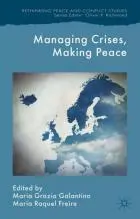
Conference on Variability and Specificity in Drug Metabolism

Évaluation des effects du tunnel sous la Manche sur les flux trafic

Learning Disorders as Barrier to Human Development - Evaluation Report

The Outdoor Mobility of Older People - Technological Support and Future Possibilities

Physico-chemical Behaviour of Atmospheric Pollutants - Activity Report

Ferroelectric Thin Films - Proceedings

COST 532 Conference: Triboscience and Tribotechnology - Superior Friction and Wear Control in Engines and Transmissions
- Pages: 248 pages
- Author(s): K. Homberg, S. Hsu, L. A. Ferreira, J. Seabra
- Publisher(s): Publindùstria, Produção de Comunicação, Lda.
- Download PDF
- ISBN/ISSN: 978-972-8953-01-0
COST Action 532 Triboscience and Tribotechnology Conference arranged jointly with the National Institute of Standards and Technology (NIST) Conference, that takes place in 12-14th October, 2005; Porto, Portugal, come at a moment when most of the projects are well advanced and the most interesting results are now being presented. The scientific level is very high and the work performed by the different working groups is very focused on industrial applications. The NIST Conference, with very distinguish speakers is a plus for this scientific meeting, in a scientific area that is highly regarded as one where major achievements in Tribology can be produced.

Managing Crises, Making Peace - Towards a Strategic EU Vision for Security and Defense
- Pages: 272
- Author(s): Galantino, M. G., Freire, M.R. (Eds.)
- Publisher(s): Palgrave Macmillan
- http://www.palgrave.com/page/detail/managing-crises,-making-peace-maria-grazia-galantino/?sf1=barcode&st1=9781137442253
This collection offers valuable insights for understanding how a distinctive EU vision on peace missions has emerged and whether it is there to last. Bringing an innovative perspective to European Union engagement in peace operations, this volume combines theoretical reflection with the analysis of empirical case studies that illustrate not only the EU’s action in the framework of its Common Security and Defense Policy (CSDP), but also how it engages with other actors in the field including international organisations, non-governmental organisations and local citizens.

National Human Rights Institutions in Europe - Comparative, European and international perspective
- Pages: 330
- Author(s): Wouters, J., Meuwissen, K. (Eds.)
- Publisher(s): Intersentia
- http://intersentia.com/en/national-human-rights-institutions-in-europe-24159.html
This book, the result of a COST conference held in Leuven in April 2012, focuses on the functioning and role of National Human Rights Institutions (NHRIs) in Europe in a comparative, European and international perspective. At a time when the European Union is looking for a more coherent and strategic human rights policy, it is important that policy makers and academics pay more attention to the potential role of NHRIs. By bringing together contributions from academics and practitioners, this volume offers insights into the opportunities and challenges that accompany the increasing emergence of NHRIs in Europe and their proliferation on the multiple levels of human rights promotion and protection. Accordingly, this volume aims to inform and further trigger the NHRI debate in Europe.
